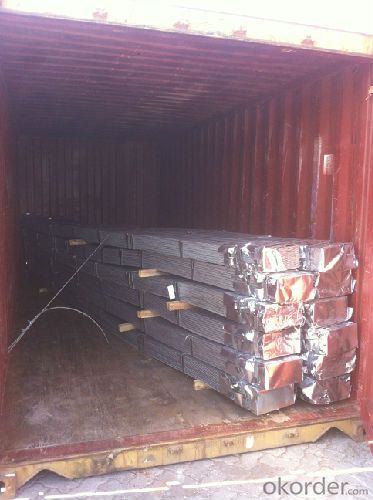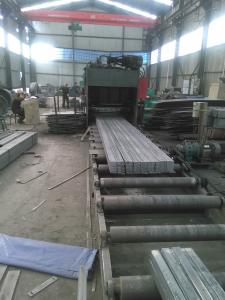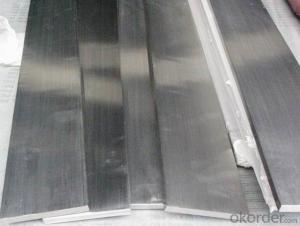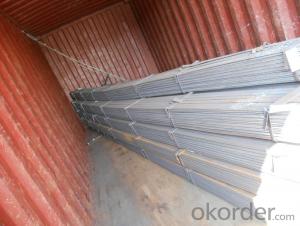ASTM A36 Steel Flat Iron Bars with Variety Sizes
- Loading Port:
- Tianjin
- Payment Terms:
- TT or LC
- Min Order Qty:
- 100 m.t.
- Supply Capability:
- 10000T m.t./month
OKorder Service Pledge
OKorder Financial Service
You Might Also Like
Product Description:
OKorder is offering ASTM A36 Steel Flat Iron Bars with Variety Sizes at great prices with worldwide shipping. Our supplier is a world-class manufacturer of steel, with our products utilized the world over. OKorder annually supplies products to African, South American and Asian markets. We provide quotations within 24 hours of receiving an inquiry and guarantee competitive prices.
Product Applications:
ASTM A36 Steel Flat Iron Bars with Variety Sizes are ideal for structural applications and are widely used in the construction of buildings and bridges, and the manufacturing, petrochemical, and transportation industries.
Product Advantages:
OKorder's ASTM A36 Steel Flat Iron Bars with Variety Sizes are durable, strong, and wide variety of sizes.
Main Product Features:
· Premium quality
· Prompt delivery & seaworthy packing (30 days after receiving deposit)
· Can be recycled and reused
· Mill test certification
· Professional Service
· Competitive pricing
Product Specifications:
Manufacture: slited
Slitting precision (width) : 0.5 mm or less
Raw material: Q235B, Q345B, Q235-1 b, A36
crosscutting precision (length) : 2 mm or less
Processing: the thickness of 2.0-16 mm;
Shear length: 2000 mm above
Wide degree: 15-1250 - mm;
Leveling precision: 1-2 MM square
Packaging: Export packing, nude packing, bundled
FAQ:
Q1: How many tons of steel products could be loaded in containers?
A1: Usually the steel products are delivered by bulk vessel because of the large quantity and the freight. However, there are no bulk vessel enter some seaports so that we have to deliver the cargo by containers. The 6m steel product can be loaded in 20FT container, but the quantity is changed according to the size, usually from 18tons to 25tons.
Q2: How do we guarantee the quality of our products?
A2: We have established an advanced quality management system which conducts strict quality tests at every step, from raw materials to the final product. At the same time, we provide extensive follow-up service assurances as required.
Q3: How soon can we receive the product after purchase?
A3: Within three days of placing an order, we will arrange production. The normal sizes with the normal grade can be produced within one month. The specific shipping date is dependent upon international and government factors, the delivery to international main port about 45-60days..
Images:


- Q:Can steel flat bars be cold worked or hot worked?
- Steel flat bars can be both cold worked and hot worked, depending on the desired outcome. Cold working refers to the process of shaping or forming the steel at room temperature through techniques such as rolling, bending, or drawing. This method is commonly used to improve the strength and hardness of the steel, as well as to achieve precise dimensions and smooth surfaces. On the other hand, hot working involves shaping or forming the steel at elevated temperatures, typically above its recrystallization temperature. This process allows for greater plasticity and easier deformation of the steel. Hot working methods include forging, extrusion, and hot rolling. It is often used to produce complex shapes, reduce internal stresses, and enhance the material's grain structure. The choice between cold working and hot working steel flat bars depends on various factors, such as the desired mechanical properties, the complexity of the shape, and the equipment and resources available. Cold working is generally preferred for smaller-scale operations and when precise dimensions and surface finish are crucial. Hot working is more suitable for larger-scale production and when the steel needs to be shaped into intricate or complex forms.
- Q:Are steel flat bars commonly used in the oil and gas industry?
- Yes, steel flat bars are commonly used in the oil and gas industry. They are widely utilized for various applications such as structural support, equipment fabrication, and reinforcement due to their high strength, durability, and versatility.
- Q:How do steel flat bars compare to glass flat bars?
- Steel flat bars are much stronger and more durable than glass flat bars. They have a higher tensile strength and are resistant to bending and breaking, making them suitable for heavy-duty applications. Glass flat bars, on the other hand, are more fragile and prone to shattering under pressure. They are primarily used for decorative purposes or in situations where transparency is required.
- Q:Are steel flat bars suitable for machine parts?
- Indeed, steel flat bars exhibit suitability for machine parts. Steel, renowned for its durability and strength, is commonly employed in the manufacturing industry across a multitude of applications. Machine parts, including brackets, supports, frames, and guides, benefit from the flat and uniform surface provided by steel flat bars. These bars possess the ability to withstand substantial loads, resist wear and tear, and confer stability and structural integrity onto the machine. Moreover, steel flat bars lend themselves to easy machining, welding, and shaping, thereby enabling customization and versatility in the design of machine parts. Consequently, due to their strength, durability, and ease of use, steel flat bars emerge as a dependable and frequently utilized choice for machine parts.
- Q:What are the different standards for steel flat bars?
- Steel flat bars, also known as steel flats or flats, are available in a variety of standards that determine their size, shape, and composition. These standards are established to guarantee consistency and excellence in the production and utilization of steel flat bars. One highly recognized standard for steel flat bars is the ASTM A36, which outlines the prerequisites for carbon structural steel. This standard specifies the chemical composition, mechanical properties, and dimensional tolerances for steel flats used in general structural purposes. Another frequently used standard is the ASTM A108, which covers carbon steel bars for general applications. This standard categorizes steel flat bars into different grades based on their chemical composition and mechanical properties. For more specialized applications, there are specific standards tailored to different industries. For example, the ASTM A276 is a standard that pertains to stainless steel bars and shapes. Within this standard, there are specific requirements for stainless steel flat bars, including their chemical composition, mechanical properties, and dimensions. In addition to ASTM standards, there are also international standards that govern the production and use of steel flat bars. The most notable one is the EN 10058, a European standard that specifies the tolerances on dimensions and shape for hot-rolled steel flat bars. Moreover, there are regional or national standards that may apply in certain countries. For instance, the JIS G3194 is a Japanese industrial standard that provides specifications for hot-rolled steel flat bars used in general structures. These standards are crucial to ensure the quality, compatibility, and interchangeability of steel flat bars in different applications. Manufacturers, engineers, and users rely on these standards to choose and work with steel flat bars that meet their specific requirements and adhere to industry norms.
- Q:Are steel flat bars suitable for aerospace applications?
- Yes, steel flat bars are suitable for aerospace applications. They offer high strength, durability, and resistance to corrosion, making them ideal for various aerospace components such as structural supports, brackets, and fittings. Additionally, steel flat bars can be easily machined and welded, allowing for precise customization and integration into aerospace systems.
- Q:What are the different types of surface defects in stainless steel flat bars?
- Stainless steel flat bars can exhibit various types of surface defects, which can be classified into several categories. Some common surface defects in stainless steel flat bars include: 1. Pitting: Pitting is the formation of small, localized corrosion spots on the surface of stainless steel flat bars. It appears as small holes or pits and is usually caused by exposure to aggressive environments such as chloride-containing solutions or acidic substances. 2. Scaling: Scaling is the formation of oxide layers on the surface of stainless steel flat bars due to high-temperature exposure. It appears as a flaky or powdery deposit and can result from processes like heat treatment or welding. 3. Corrosion: Corrosion refers to the gradual deterioration of the stainless steel surface due to chemical reactions with the environment. It can occur in various forms, including uniform corrosion, crevice corrosion, or stress corrosion cracking, depending on the specific conditions and environment. 4. Scratches: Scratches are physical marks on the surface of stainless steel flat bars caused by abrasive contact or mechanical damage. They can vary in depth and severity, and if not properly addressed, they can create localized areas of stress concentration and potential sites for further corrosion. 5. Roll marks: Roll marks are surface imperfections that occur during the manufacturing process of stainless steel flat bars. They appear as irregular patterns or lines on the surface and are typically caused by the rolling or finishing equipment used in production. 6. Discoloration: Discoloration refers to the change in the appearance or color of the stainless steel flat bar surface. It can be caused by exposure to high temperatures, chemical reactions, or improper cleaning methods. Discoloration can appear as light or dark patches, streaks, or a rainbow-like effect known as "heat tint" in the case of overheating during welding. It is important to note that surface defects in stainless steel flat bars can not only impact the aesthetic appeal but also compromise the material's corrosion resistance, mechanical properties, and overall performance. Therefore, it is crucial to identify, assess, and address any surface defects promptly to ensure the longevity and reliability of stainless steel flat bars.
- Q:What is the tensile force of the galvanized flat steel of 20*3?
- Since the specifications require that the stationary support be able to withstand the 49N pull, I wonder if this flat steel can withstand such a large pull to choose the flat type;
- Q:Are steel flat bars suitable for creating industrial equipment or machinery?
- Steel flat bars are a suitable option for the creation of industrial equipment or machinery. These bars are renowned for their strength, durability, and resistance to wear and tear, making them an excellent choice for heavy-duty applications across various industries. They can be easily manipulated, fabricated, and welded to produce different components, structures, or frameworks needed in industrial equipment or machinery. Moreover, steel flat bars possess exceptional load-bearing capabilities and can endure high levels of stress, ensuring their reliability in supporting heavy loads and providing structural stability. In summary, steel flat bars are extensively utilized in the manufacturing of industrial equipment or machinery due to their advantageous mechanical properties and ability to withstand challenging working conditions.
- Q:What are the different sizes of steel flat bars?
- To accommodate different needs and purposes, steel flat bars are available in various sizes. Examples of common sizes include 1/8 inch thick by 1/2 inch wide, 1/4 inch thick by 1/2 inch wide, 3/8 inch thick by 1/2 inch wide, and 1/2 inch thick by 1/2 inch wide. However, these are merely a few illustrations, as steel flat bars are obtainable in a wide assortment of thicknesses and widths. Some larger options might be 1 inch thick by 4 inches wide or even larger. The appropriate size of a steel flat bar required will rely on the intended usage, load-bearing capacity, and the desired strength of the steel. It is essential to consult a steel supplier or refer to an industry standard to ascertain the suitable size for a particular application.
1. Manufacturer Overview |
|
|---|---|
| Location | |
| Year Established | |
| Annual Output Value | |
| Main Markets | |
| Company Certifications | |
2. Manufacturer Certificates |
|
|---|---|
| a) Certification Name | |
| Range | |
| Reference | |
| Validity Period | |
3. Manufacturer Capability |
|
|---|---|
| a)Trade Capacity | |
| Nearest Port | |
| Export Percentage | |
| No.of Employees in Trade Department | |
| Language Spoken: | |
| b)Factory Information | |
| Factory Size: | |
| No. of Production Lines | |
| Contract Manufacturing | |
| Product Price Range | |
Send your message to us
ASTM A36 Steel Flat Iron Bars with Variety Sizes
- Loading Port:
- Tianjin
- Payment Terms:
- TT or LC
- Min Order Qty:
- 100 m.t.
- Supply Capability:
- 10000T m.t./month
OKorder Service Pledge
OKorder Financial Service
Similar products
New products
Hot products
Related keywords




























